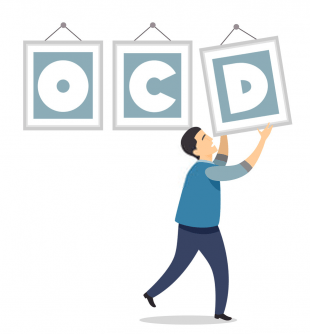Introduction
In this post we will focus on understanding the psychological defense mechanism of Magical Undoing, along with the steps therapists can take to help client move beyond this defense.
Magical Undoing: Examples
Instance 1: When the teacher asked me why I bunked class the other day, I crossed my fingers behind my back before lying so that God wouldn’t punish me.
Instance 2: “God forbid, if I fail—touch wood..”, says Maria touching a nearby wooden chair, “..then, I will go back to my hometown this time.”
Instance 3: My annoying elder brother, always so conscious about his height, yelled at me for crossing over his outstretched legs. “You’re blocking the way there, Shorty!” I snort. “I don’t care. You better cross over again, lest I might get stunted to this height of 5’8” forever!”
Each of these instances is no doubt smeared with superstitious beliefs.
What is interesting is that, not only are the beliefs superficial, but so are the actions used to avoid the consequences of supposedly “cursed” behaviour.
That is to say, no one really knows what God does to liars. Still, there is a popular belief that ‘naughty children’ are punished by the Almighty. To counter this undesirable consequence, kids usually cross their fingers behind the back, expecting this to undo the lying behaviour.
Does this action, in reality, reverse the lying motive in the first place?
Of course not!
It simply provides us with a false mental satisfaction that we haven’t done anything wrong for which we’re liable to face the brunt. Touching wood to avoid bad luck and crossing over someone’s feet twice to save them from turning into dwarfs are ideologies that work on similar lines.
What is Magical Undoing?
Magical undoing is a combination of two defense mechanisms, namely, magical thinking and undoing.
Magical thinking
Magical thinking typically refers to a particular kind of collection of thoughts or rather a thinking pattern in itself whereby individuals believe that they/others have control over certain phenomena which can’t really be tamed by any human as such.
Thus, it is essentially impossible that you will stop growing in your height if a sibling jumps over your feet. No, your sibling doesn’t hold that power. Still, you imagine them to do. This is magical thinking.
Undoing
Undoing, as we have discussed earlier, refers to actions performed in response to certain previous actions in order to negate the latter. Thus, when Maria touches the wooden chair, she is attempting to go back on her negatively framed and possibly jinxed sentence of failing an exam.
The interesting thing to notice in case of magical undoing is that the two actions are not really related to one another. So, in Maria’s case the action of touching the wooden chair is totally unrelated to the action of failing. Logically speaking, how can touching a wooden chair stop Maria from failing?
 Magical Undoing in Religion
Magical Undoing in Religion
Examples of Magical undoing are also visible in certain religious or spiritual practices like confessions in a church or taking a bath in a holy river (E.g. Ganga).
Many people believe irrespective of what sins (crimes) they have committed, Confession to a Priest or taking a bath in river Ganga would help them cleanse themselves and that sins will be wiped out.
You can see traces of Magical undoing in these concepts, can’t you?
Usefulness of Magical Undoing
Important thing to remember is that like other defense mechanisms even Magical Undoing is useful in specific cases.
Take the example of a criminal who wants to start a fresh but is afraid of his past sins coming to bite him. Wouldn’t the idea that Confession will help him wipe out his sins thereby allowing him to start a fresh, useful?
It is, isn’t it?
Problem with Magical Undoing
That said, the same defense can become a problem if the person continues with criminal activities thinking that once every year I can confess, wipe out my sins and start with criminal activities a fresh. Once I feel the sins have accumulated again, I can go offer another confession and the process can continue…. This is one of the reasons why many terrorists will also be very particular about their religious practices.
 Another place where magical undoing can create problems because it can lead to compulsive behaviours which in the long run may lead to Obsessive Compulsive Disorder (OCD).
Another place where magical undoing can create problems because it can lead to compulsive behaviours which in the long run may lead to Obsessive Compulsive Disorder (OCD).
OCD is a type of anxiety disorder characterized by recurring unwanted thoughts, images or sensations (obsessions) followed by repeated engagement in unneeded actions (compulsions) to get rid of the anxiety aroused by the former. The idea is that the compulsive behavior will help in dealing with the obsession or at least the anxiety aroused by the same.
Therapists Niche: Working with Magical Undoing
To understand what therapists can do to help a client using Magical Undoing as a defense, let us begin by understanding when is this defense used. Generally, people use magical undoing to deal with anxiety in two scenarios:
- When they have made mistakes in the past but would like to start a fresh.
- When they do not have the skills to deal with a situation that induces fear or guilt in them.
Therapists in each of these cases should help the clients:
- Get into the right mental state by helping them let go of:
- The emotional burden associated with the past mistakes
- The guilt / fear which is stored in the clients system as a result of the situation.
- Develop the required skills to:
- Not make the past mistakes again and start a fresh.
- Help them deal with the fear or guilt inducing situation more effectively with the help of an alternative strategy / strategies.
Different techniques that therapists can use to help the clients
 Help the clients explore their emotions and past experiences with the help of the NLP meta model and corrective therapy
Help the clients explore their emotions and past experiences with the help of the NLP meta model and corrective therapy- Help the clients let go of old stored guilt or fear by using techniques like the hypnotic version of ho’oponopono, inner child therapy, regression therapy and other cathartic processes from Psycho-analysis.
- Help the client get insights from their past experiences with the help of revelation and introspection metaphors.
- Help the clients identify the required skills with the help of Meta model questions and the SOFT SEA™ framework.
- Help the client get into the right mental state with the help of techniques like anchoring, If-then statements, SWISH….
All these techniques and a lot more are covered in our Cognitive Hypnotic Psychotherapy™ Program. If you are a psychologist who would like to develop advanced therapeutic skills based on an eclectic approach to therapy, then you must check out the course curriculum. I am sure you would love the same.


 Magical Undoing in Religion
Magical Undoing in Religion Help the clients explore their emotions and past experiences with the help of the
Help the clients explore their emotions and past experiences with the help of the